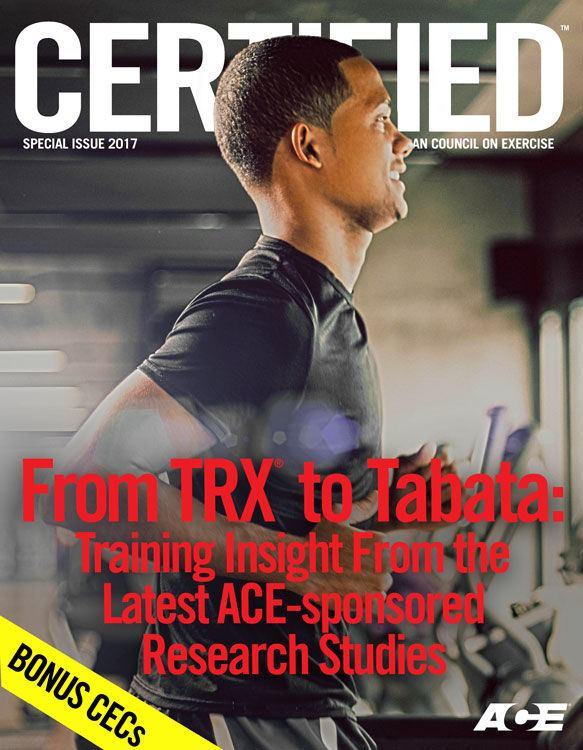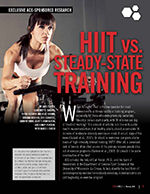
It is important to highlight the fact that this research focused on previously sedentary individuals in an attempt to mirror newcomers to a fitness facility who had been doing very little activity prior to joining. Every client’s abilities, needs and goals are different, and each type of cardiorespiratory exercise included in this study can be featured in a well-designed exercise program.
Where to begin? That is the key question for most newcomers to a fitness facility or training program, especially for those who were previously sedentary. Should a person start slowly, with 30 minutes per day of treadmill walking? This amount of activity is in line with public health recommendations that healthy adults should accumulate 30 minutes of moderate-intensity exercise on most, if not all, days of the week (Haskell et al., 2007). Or should a newcomer complete shorter bouts of high-intensity interval training (HIIT)? After all, a perceived lack of time is often cited as one of the primary reasons people drop out of exercise programs (Salmon et al., 2003). Or should it be some combination of the two?
ACE enlisted the help of Carl Foster, Ph.D., and his team of researchers in the Department of Exercise Sport Science at the University of Wisconsin–La Crosse, to help identify the best form of cardiorespiratory exercise for relatively sedentary individuals who are just beginning an exercise program.
The Study
Researchers recruited 65 relatively sedentary individuals (23 male, 42 female), ranging from 18 to 28 years old, 55 of whom completed the study (Table 1). To be eligible to participate, the subjects could not have been exercising more than twice per week at low-to-moderate intensities during the preceding three months. Prior to the study, subjects completed an incremental exercise test on a cycle ergometer to determine aerobic capacity, during which maximal heart rate (MHR) and respiratory metabolism were measured and ratings of perceived exertion (RPE) were collected. A second cycle ergometer test was performed to measure anaerobic power—peak power output and mean power output were recorded [in Watts (W) per kilogram of body weight].
After these preliminary tests, male and female subjects were separately stratified into three groups based on the results. They were then randomly assigned into one of three training groups (all three groups performed identical five-minute warm-ups and cool-downs in addition to what is described below). Training was performed on mechanically braked ergometers.
Steady-state Group: 20 minutes of continuous exercise at 90 percent of the individual’s ventilatory threshold (Foster and Cotter, 2005). This fits into the moderate-to-vigorous intensity category, as defined by the American College of Sports Medicine (ACSM, 2014).
Tabata Group: This is very brief, very high-intensity interval training consisting of four minutes (eight sets) of exercise consisting of 20 seconds of work (at 170 percent of the individual’s peak aerobic power) paired with 10 seconds of unloaded pedaling (Tabata et al., 1996).
Meyer Group: This is moderate-intensity interval training consisting of 20 minutes (13 sets) of 30-second work intervals (100 percent of the individual’s peak aerobic power) paired with 60 seconds of activity recovery (Meyer et al., 1990).
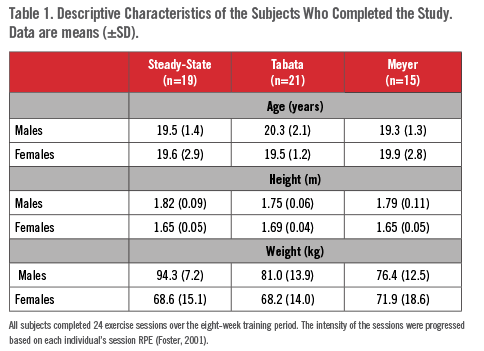
All subjects completed 24 exercise sessions over the eight-week training period. The intensity of the sessions were progressed based on each individual’s session RPE (Foster, 2001).
The Results
The acute responses during the training program are presented in Figure 1. There was a progressive increase in power output in all three groups: 50 W in the Steady-state Group (a 50 percent increase), 45 W in the hard segment of the Meyer Group (a 45 percent increase) and 70 W in the hard segment of the Tabata Group (an 18 percent increase). Despite these progressions in the external training load, markers of the internal training load (percent of heart-rate reserve, session RPE and blood lactate) remained constant during the eight-week study (see Figure 1).
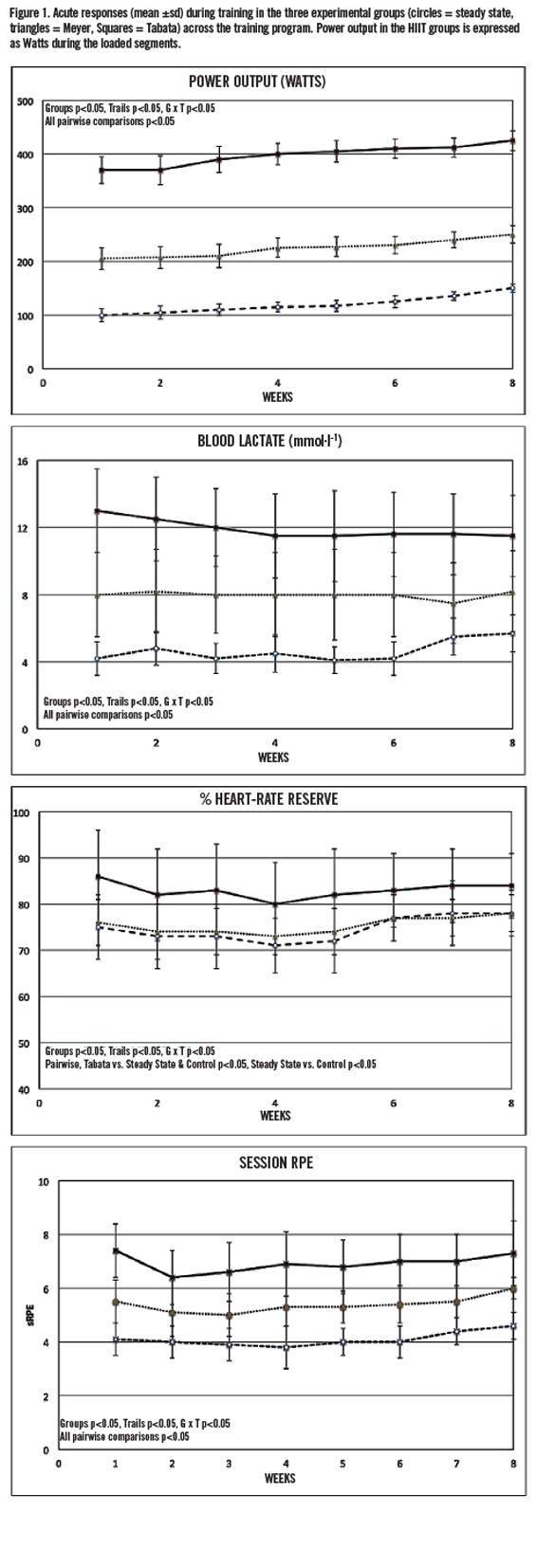
VO2max changed significantly in all three groups over the course of the study. An increase of approximately 18 percent was seen, with no differences between training groups. When the data were expressed as body weight–normalized power output, there were significant changes across training in all groups, with no differences between groups. When the body weight–normalized power output was expressed as the combined exercise capacity, there was a 6 to 10 percent increase with training, but no difference between groups (Table 2).
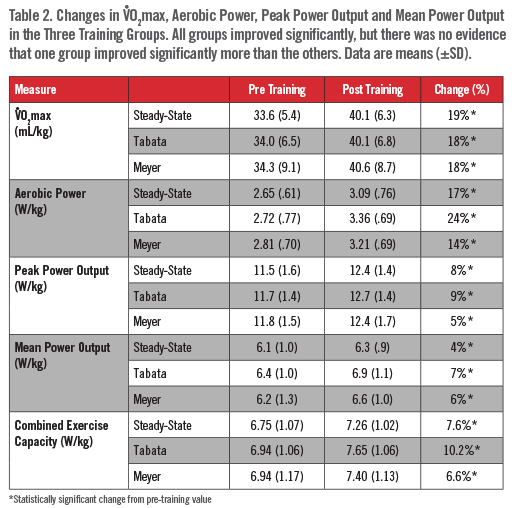
The Bottom Line
The main finding of this study is the increase in measures of both aerobic and anaerobic exercise performance seen in all three training groups. Contrary to the frequent claims in the literature of larger responses following high-intensity exercise training programs, in this group of relatively untrained young adults there was no apparent advantage gained from more intense exercise. While the Tabata Group did see greater increases in all measures of exercise capacity, there was not a significantly larger increase in the combined exercise capacity in any of the groups (see Table 2).
Couple these results with the enjoyment considerations (see shaded box, “The Enjoyment Factor”), and the take-away message is that programs need to be tailored to the personality and goals of the individual, and they must offer enough variety to keep things interesting. “The natural implication of these results,” argues Dr. Foster, “is that variety is at least as important as the details of the program.”
Dr. Foster has concerns about two other claims frequently made about HIIT. The first claim centers on the time-efficiency of this type of workout (i.e., better results in less time). The workout durations in this study reflect that claim (30 minutes for the Steady-state and Meyer Groups and 14 minutes for the Tabata Group, including warm-up and cool-down). Dr. Foster says that the members of the Tabata Group were “really feeling it” after their workouts, while the other subjects were able to quickly return to their daily routines. “Additional recovery time was needed following the Tabata workouts,” Dr. Foster points out, “so the time-efficiency is a bit of an illusion.”
The second claim in much of the HIIT literature is about the rapid improvements seen in response to the larger stimuli of this type of workout. “But what is the best real-world program?” asks Dr. Foster. If exercisers complain of more fatigue and enjoy the workouts less, dropout may be imminent. Aside from sustaining an injury, this is one of the worst possible outcomes of an exercise program.
There is, however, one caveat regarding the results of this study: Untrained populations will almost always see a robust response to any type of exercise, which may explain the uniformity of the results seen here. That said, these participants are a good reflection of new members joining a fitness facility for the first time—and the primary goal when working with these newcomers should be to introduce enjoyable experiences related to physical activity. If all three types of training yield similar results during the early stages of a program, health and fitness professionals would be wise to focus on the enjoyment factor and just keep their clients moving and motivated to come back for the next workout.
The Enjoyment Factor
One day during each week of the eight-week program, study participants completed the Exercise Enjoyment Scale (EES) (Stanley, Williams and Cumming, 2010). The EES was administered before, during and after training to determine the subject’s perceived level of enjoyment (on a scale of 0 to 7).
The major finding was that the EES declined progressively across the duration of the study for all three groups. Additionally, the EES was lowest during the most intense training scheme (i.e., the Tabata Group). Stated simply, the subjects were significantly less likely to enjoy the most intense training protocol, and their enjoyment of all of the protocols declined over time.
Tabata-type protocols (very high-intensity intervals with very short recovery periods) are so physically challenging that they are unlikely to be perceived as pleasant. Regardless of how effective an exercise training program might be, adherence over any meaningful period of time is unlikely in programs that are not enjoyable.
The fact that the participants’ level of enjoyment was declining over the course of the study in all three training groups should be highly concerning to health and fitness professionals, as it is likely that most of these newcomers to exercise would drop out of their programs in the coming weeks if their enjoyment of exercise continued to wane (and it is certainly possible that being part of a research study is all that kept some of them on board). Given that dropout is a primary concern for all new clients, identifying the most enjoyable program, rather than the most effective one, could be an important focus of future research.
References
American College of Sports Medicine (2014), ACSM’s Guidelines for Exercise Testing and Prescription (9th ed.). Philadelphia: Wolters Kluwer/Lippincott Williams & Wilkins.
Foster, C. et al. (2001). Monitoring exercise training during non-steady state exercise. Journal of Strength Conditioning Research, 15, 109–115.
Foster, C. and Cotter, H.M. (2005). Blood lactate, respiratory and heart rate markers on the capacity for sustained exercise. In: Maud, P.J. and Foster, C. (Eds). Physiological Assessment of Human Fitness (2nd ed.). Champaign, Ill.: Human Kinetics. p. 63–76.
Haskell, W.L. et al. (2007). Physical activity and public health recommendation for adults from the American College of Sports Medicine and the American Heart Association. Medicine & Science in Sports & Exercise, 39, 1423–1434.
Meyer, K. et al. (1990). Interval versus continuous exercise training after coronary bypass surgery: A comparison of training-induced acute reactions with respect to the effectiveness of the exercise methods. Clinical Cardiology, 13, 851–861.
Salmon, J. et al. (2003). Physical activity and sedentary behavior: A population-based study of barriers, enjoyment and preference. Health Psychology, 22, 178–188.
Stanley, D.M., Williams, S.E. and Cumming, J. (2010). Are we having fun yet? Testing the effects of imagery use on the affective and enjoyment responses to acute moderate exercise. Psychology of Sport and Exercise, 11, 582–590.
Tabata, I. et al. (1996). Effects of moderate-intensity endurance and high-intensity intermittent training on anaerobic capacity and VO2max. Medicine & Science in Sports & Exercise 28, 1327–1330.
Why Does ACE Sponsor Fitness-related Research Studies?
This study was sponsored by the American Council on Exercise. For more than 20 years, ACE has commissioned independent research studies from major universities and trusted partners across the country, covering everything from infomercial fitness products to the effectiveness of some of the hottest trends in health and fitness. ACE is committed to investing in these studies as part of its mission to promote the benefits of physical activity and to protect people from unsafe and ineffective fitness products and trends. You can find more information about past ACE-sponsored studies, including research on the best abdominal exercises, kettlebell workouts and Zumba, by clicking here.





